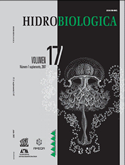Tissue changes of the oyster Crassostrea virginica due to cadmium exposition and depuration
Keywords:
Oyster, Crassostrea virginica, cadmium, histopathological.Abstract
Cadmium levels had increased in the Gulf of Mexico, this represents a potential risk for the survival of oyster Crassostrea virginica and for those who eat them, so it is important to evaluate the effects of cadmium trough histopathological changes derived from the exposition to this metal and during its depuration. Oysters exposed to 100 µg/l of cadmium for 72 h and depurated by 24, 48, 72, 96, 120, 144, 168, 192, 216, and 230 h were analyzed. Samples of oysters were included in paraffin, cutted in a microtome and stained following the Hematoxilin-Eosin technique. Histopathological analysis of oesophagus, intestine, digestive diverticulum, gills and mantle, showed inflammatory lesions and cell activation, including brown cells and haemocytes as a detoxification mechanism. The conjunctive tissue next to oesophagus, intestine and digestive diverticulum presented more brown cells and haemocytes than gills and mantle. Histopathological damage was not reversible in 230 h, although there was a recovery in epitheliums of digestive diverticulum. This work recommends the histopathological evaluation of digestive diverticulum to determine the physiological state of oysters and to take preventive measures in the commercialization and culture of their natural populations.Downloads
Downloads
Published
How to Cite
Issue
Section
License
Los autores/as que publiquen en esta revista aceptan las siguientes condiciones:
De acuerdo con la legislación de derechos de autor, HIDROBIOLÓGICA reconoce y respeta el derecho moral de los autores, así como la titularidad del derecho patrimonial, el cual será cedido a la revista para su difusión en acceso abierto.
Publicar en la revista HIDROBIOLÓGICA tiene un costo de recuperación de $500 pesos mexicanos por página en blanco y negro (aproximadamente 29 dólares americanos) y $1000 pesos por página a color (aproximadamente 58 dólares americanos).
Todos los textos publicados por HIDROBIOLÓGICA sin excepción se distribuyen amparados bajo la licencia Creative Commons 4.0Atribución-No Comercial (CC BY-NC 4.0 Internacional), que permite a terceros utilizar lo publicado siempre que mencionen la autoría del trabajo y a la primera publicación en esta revista.
Los autores/as pueden realizar otros acuerdos contractuales independientes y adicionales para la distribución no exclusiva de la versión del artículo publicado en HIDROBIOLÓGICA (por ejemplo incluirlo en un repositorio institucional o publicarlo en un libro) siempre que indiquen claramente que el trabajo se publicó por primera vez en HIDROBIOLÓGICA.
Para todo lo anterior, el o los autor(es) deben remitir el formato de Carta-Cesión de la Propiedad de los Derechos de la primera publicación debidamente requisitado y firmado por el autor(es). Este formato se puede enviar por correo electrónico en archivo pdf al correo: enlacerebvistahidrobiológica@gmail.com; rehb@xanum.uam.mx (Carta-Cesión de Propiedad de Derechos de Autor).
Esta obra está bajo una licencia de Creative Commons Reconocimiento-No Comercial 4.0 Internacional.


